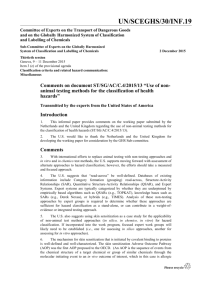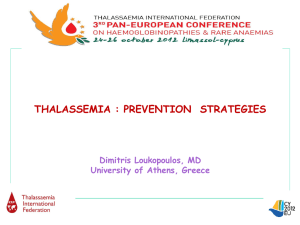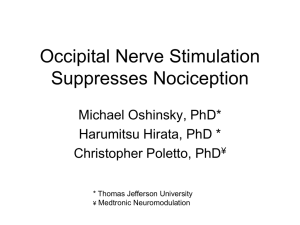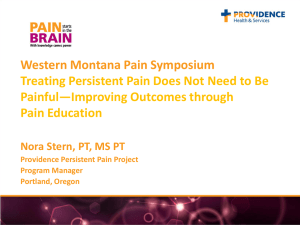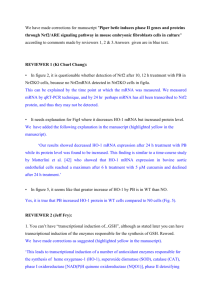SenCeeTox ® Method - PETA International Science Consortium Ltd.
advertisement
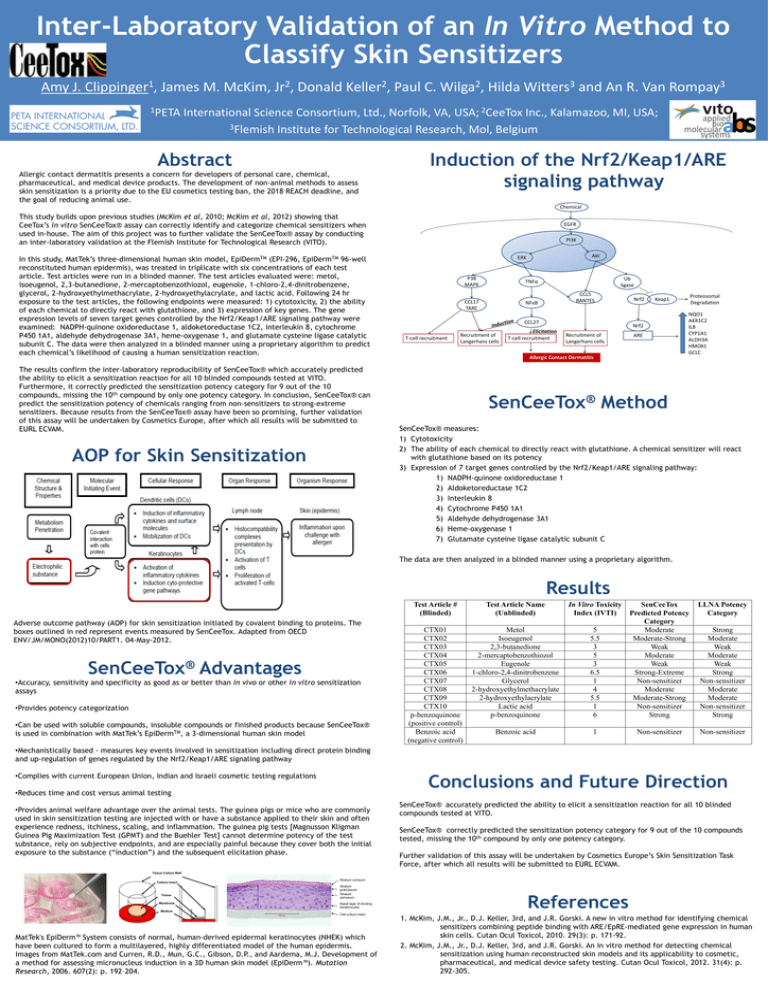
Inter-Laboratory Validation of an In Vitro Method to Classify Skin Sensitizers Amy J. 1 Clippinger , • James M. McKim, 1PETA 2 Jr , Donald 2 Keller , Paul C. 2 Wilga , Hilda 3 Witters and An R. Van 3 Rompay International Science Consortium, Ltd., Norfolk, VA, USA; 2CeeTox Inc., Kalamazoo, MI, USA; 3Flemish Institute for Technological Research, Mol, Belgium Abstract Allergic contact dermatitis presents a concern for developers of personal care, chemical, pharmaceutical, and medical device products. The development of non-animal methods to assess skin sensitization is a priority due to the EU cosmetics testing ban, the 2018 REACH deadline, and the goal of reducing animal use. Induction of the Nrf2/Keap1/ARE signaling pathway Chemical This study builds upon previous studies (McKim et al, 2010; McKim et al, 2012) showing that CeeTox’s in vitro SenCeeTox® assay can correctly identify and categorize chemical sensitizers when used in-house. The aim of this project was to further validate the SenCeeTox® assay by conducting an inter-laboratory validation at the Flemish Institute for Technological Research (VITO). In this study, MatTek’s three-dimensional human skin model, EpiDermTM (EPI-296, EpiDermTM 96-well reconstituted human epidermis), was treated in triplicate with six concentrations of each test article. Test articles were run in a blinded manner. The test articles evaluated were: metol, isoeugenol, 2,3-butanedione, 2-mercaptobenzothiozol, eugenole, 1-chloro-2,4-dinitrobenzene, glycerol, 2-hydroxyethylmethacrylate, 2-hydroxyethylacrylate, and lactic acid. Following 24 hr exposure to the test articles, the following endpoints were measured: 1) cytotoxicity, 2) the ability of each chemical to directly react with glutathione, and 3) expression of key genes. The gene expression levels of seven target genes controlled by the Nrf2/Keap1/ARE signaling pathway were examined: NADPH-quinone oxidoreductase 1, aldoketoreductase 1C2, interleukin 8, cytochrome P450 1A1, aldehyde dehydrogenase 3A1, heme-oxygenase 1, and glutamate cysteine ligase catalytic subunit C. The data were then analyzed in a blinded manner using a proprietary algorithm to predict each chemical’s likelihood of causing a human sensitization reaction. The results confirm the inter-laboratory reproducibility of SenCeeTox® which accurately predicted the ability to elicit a sensitization reaction for all 10 blinded compounds tested at VITO. Furthermore, it correctly predicted the sensitization potency category for 9 out of the 10 compounds, missing the 10th compound by only one potency category. In conclusion, SenCeeTox® can predict the sensitization potency of chemicals ranging from non-sensitizers to strong-extreme sensitizers. Because results from the SenCeeTox® assay have been so promising, further validation of this assay will be undertaken by Cosmetics Europe, after which all results will be submitted to EURL ECVAM. AOP for Skin Sensitization EGFR PI3K Akt ERK P38 MAPK Ub ligase TNFα CCL17 TARC CCL5 RANTES NFκB Nrf2 CCL27 T-cell recruitment Recruitment of Langerhans cells Nrf2 Elicitation T-cell recruitment Recruitment of Langerhans cells ARE Allergic Contact Dermatitis ® SenCeeTox Proteosomal Degradation Keap1 NQO1 AKR1C2 IL8 CYP1A1 ALDH3A HMOX1 GCLC Method SenCeeTox® measures: 1) Cytotoxicity 2) The ability of each chemical to directly react with glutathione. A chemical sensitizer will react with glutathione based on its potency 3) Expression of 7 target genes controlled by the Nrf2/Keap1/ARE signaling pathway: 1) NADPH-quinone oxidoreductase 1 2) Aldoketoreductase 1C2 3) Interleukin 8 4) Cytochrome P450 1A1 5) Aldehyde dehydrogenase 3A1 6) Heme-oxygenase 1 7) Glutamate cysteine ligase catalytic subunit C The data are then analyzed in a blinded manner using a proprietary algorithm. Results Adverse outcome pathway (AOP) for skin sensitization initiated by covalent binding to proteins. The boxes outlined in red represent events measured by SenCeeTox. Adapted from OECD ENV/JM/MONO(2012)10/PART1. 04-May-2012. ® SenCeeTox Advantages •Accuracy, sensitivity and specificity as good as or better than in vivo or other in vitro sensitization assays •Provides potency categorization •Can be used with soluble compounds, insoluble compounds or finished products because SenCeeTox® is used in combination with MatTek’s EpiDermTM, a 3-dimensional human skin model Test Article # (Blinded) Test Article Name (Unblinded) In Vitro Toxicity Index (IVTI) LLNA Potency Category 5 5.5 3 5 3 6.5 1 4 5.5 1 6 SenCeeTox Predicted Potency Category Moderate Moderate-Strong Weak Moderate Weak Strong-Extreme Non-sensitizer Moderate Moderate-Strong Non-sensitizer Strong CTX01 CTX02 CTX03 CTX04 CTX05 CTX06 CTX07 CTX08 CTX09 CTX10 p-benzoquinone (positive control) Benzoic acid (negative control) Metol Isoeugenol 2,3-butanedione 2-mercaptobenzothiozol Eugenole 1-chloro-2,4-dinitrobenzene Glycerol 2-hydroxyethylmethacrylate 2-hydroxyethylacrylate Lactic acid p-benzoquinone Benzoic acid 1 Non-sensitizer Non-sensitizer Strong Moderate Weak Moderate Weak Strong Non-sensitizer Moderate Moderate Non-sensitizer Strong •Mechanistically based - measures key events involved in sensitization including direct protein binding and up-regulation of genes regulated by the Nrf2/Keap1/ARE signaling pathway •Complies with current European Union, Indian and Israeli cosmetic testing regulations •Reduces time and cost versus animal testing •Provides animal welfare advantage over the animal tests. The guinea pigs or mice who are commonly used in skin sensitization testing are injected with or have a substance applied to their skin and often experience redness, itchiness, scaling, and inflammation. The guinea pig tests [Magnusson Kligman Guinea Pig Maximization Test (GPMT) and the Buehler Test] cannot determine potency of the test substance, rely on subjective endpoints, and are especially painful because they cover both the initial exposure to the substance (“induction”) and the subsequent elicitation phase. Conclusions and Future Direction SenCeeTox® accurately predicted the ability to elicit a sensitization reaction for all 10 blinded compounds tested at VITO. SenCeeTox® correctly predicted the sensitization potency category for 9 out of the 10 compounds tested, missing the 10th compound by only one potency category. Further validation of this assay will be undertaken by Cosmetics Europe’s Skin Sensitization Task Force, after which all results will be submitted to EURL ECVAM. References MatTek's EpiDerm™ System consists of normal, human-derived epidermal keratinocytes (NHEK) which have been cultured to form a multilayered, highly differentiated model of the human epidermis. Images from MatTek.com and Curren, R.D., Mun, G.C., Gibson, D.P., and Aardema, M.J. Development of a method for assessing micronucleus induction in a 3D human skin model (EpiDerm™). Mutation Research, 2006. 607(2): p. 192–204. 1. McKim, J.M., Jr., D.J. Keller, 3rd, and J.R. Gorski. A new in vitro method for identifying chemical sensitizers combining peptide binding with ARE/EpRE-mediated gene expression in human skin cells. Cutan Ocul Toxicol, 2010. 29(3): p. 171-92. 2. McKim, J.M., Jr., D.J. Keller, 3rd, and J.R. Gorski. An in vitro method for detecting chemical sensitization using human reconstructed skin models and its applicability to cosmetic, pharmaceutical, and medical device safety testing. Cutan Ocul Toxicol, 2012. 31(4): p. 292-305.
